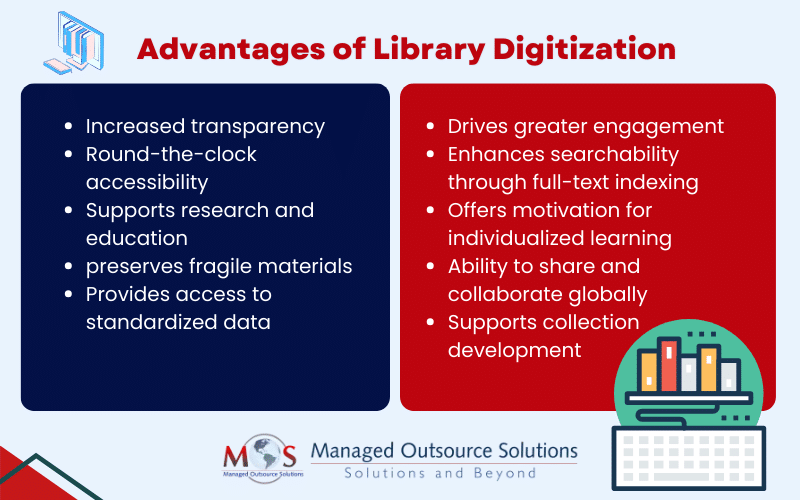The digitization of academic libraries is growing rapidly. Traditional brick and mortar libraries underwent a transformation with the rapid digitalization and computerization both the educational process and research activities. Over the years, libraries across the world leveraged document scanning services to digitize thousands of collections of physical books on various subjects. If you are a student or researcher, you can search digital libraries for books written in many different languages, including books that are rare, out of print, or unavailable outside of the library system.
Digital collections in libraries are growing. According to Verified Market Reports, the libraries and archives market size, which was valued at $76.99 million in 2023, is expected to reach $96.91 million by 2030, growing at a CAGR of 4.7% during the forecast period 2024-2030.
Digitizing and Managing Academic Resources
Digital libraries provide online access to electronic versions of physical books, documents, manuscripts and associated images as well as other multi-media content like audio and video. Digital materials can be accessed on technology-assisted learning tools such as mobile devices, smartboards, massive open online courses (MOOCs), tablets, and laptops. Digitization is crucial to leverage AI-powered algorithms that allow users to retrieve information accurately and efficiently.
The goal of library digitization is to make the content library collections available electronically. So how is this transformation achieved?
Digitization of library resources typically involves:
- Scanning or photographing the original materials
Scanning converts the existing paper-based (of sound, vides) collection into digital content. It includes document scanning, book and large format scanning, aperture card microfilm and microfiche scanning, and graphic arts scanning. A key feature of the process, optical character recognition (OCR) recognizes symbols and characters and processes them into a computer-readable document. Scans should fully capture the subject content of image, including the finest details and range of tones. - Creating high-quality digital reproductions
Images are adjusted after capture to produce high quality representation of the original material. At the same time, no other post-processing is applied to recreate missing elements of the images, or to improve the overall aesthetics of the photograph.
- Capturing relevant metadata
Descriptive metadata contains information about the object’s content, including title, author, notes, etc., used for discovery of the digital object. Administrative metadata contains information that will help in management and preservation, including the file type, when it was created, etc.
These digital materials can then be stored and organized for access through online platforms, digital libraries, or institutional repositories. Proper planning, vision, and strategy are crucial for implementing library digitization. The methodology should be in keeping with the policies of each institution.
Benefits of Library Digitization
Digitizing library resources can ensure effective management and organization of data and provide better access to information when the academic community needs it.
However, library digitization projects also come with challenges such as copyright considerations, high costs, resource and funding constraints, technological infrastructure, and the necessity for ongoing preservation and maintenance. Nevertheless, digitizing their collections is essential for libraries to embrace the era of technology and serve a wider audience.
Document Conversion Services – A Cost-effective Solution
Digital library projects require massive resources, both human and technological. It also requires frequent hardware and software upgrades, and with increasing cost of subscription, upgrades can be a challenge. Fortunately, document digitization services offer a cost-effective solution. It provides libraries with access to the advanced equipment and skills required to capture high quality digital images of the original materials. Experienced service providers are mindful when handling damaged documents and materials that are large, fragile, and/or bulky. Working with a reliable company can ensure high quality digital images and go a long way in supporting the sustainability of digital access to library resources.





